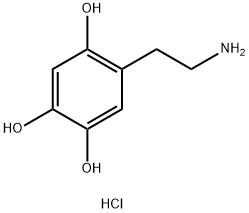6-HYDROXYDOPAMINE HYDROCHLORIDE
Synonym(s):2-(2,4,5-Trihydroxyphenyl)ethylamine hydrochloride;2,4,5-Trihydroxyphenethylamine hydrochloride;2,5-Dihydroxytyramine hydrochloride;6-OHDA
- CAS NO.:28094-15-7
- Empirical Formula: C8H12ClNO3
- Molecular Weight: 205.64
- MDL number: MFCD00012895
- EINECS: 248-837-2
- SAFETY DATA SHEET (SDS)
- Update Date: 2024-11-19 23:02:33

What is 6-HYDROXYDOPAMINE HYDROCHLORIDE?
Description
6-Hydroxydopamine hydrochloride (6-OHDA) is a neurotoxin, commonly used to induce Parkinson′s disease (PD). 6-OHDA causes death of dopaminergic neurons in substantia nigra pars compacta progressively mimicking PD. 6-OHDA is highly oxidizable and cannot cross blood brain barrier. 6-OHDA exerts cytotoxicity by generating reactive oxygen species, initiating cellular stress and cell death. 6-OHDA leads to neuronal cell death in many in vitro models like primary neuronal culture, human neuroblastoma cell line and rat adrenal pheochromocytoma cell line, PC12.
The Uses of 6-HYDROXYDOPAMINE HYDROCHLORIDE
6-hydroxydopamine hydrochloride has been used:
- to induce Parkinson′s disease (PD) in rats
- to analyse cytotoxic effect of 6-OHDA on PC12 cell line
- to induce noradrenergic (NA) neuron deletion from the locus-coeruleus
The Uses of 6-HYDROXYDOPAMINE HYDROCHLORIDE
6-Hydroxydopamine is a selective catecholaminergic neurotoxin. Studies show that 6-Hydroxydopamine can be used to create an animal model of Parkinson's disease as it causes almost complete destruction of nigral dopaminergic neurons and their striatal terminals when injected into the substantia nigra of rats. 6-Hydroxydopamine induces apoptosis in PC12 cells.
What are the applications of Application
6-Hydroxydopamine hydrochloride is a selective catecholaminergic neurotoxin
General Description
Beige solid.
Air & Water Reactions
Hygroscopic. Water soluble.
Reactivity Profile
A weak acid. Materials in this group are generally soluble in water. The resulting solutions contain moderate concentrations of hydrogen ions and have pH's of less than 7.0. They react as acids to neutralize bases. These neutralizations generate heat, but less or far less than is generated by neutralization of inorganic acids, inorganic oxoacids, and carboxylic acid. They usually do not react as either oxidizing agents or reducing agents but such behavior is not impossible. Many of these compounds catalyze organic reactions.
Health Hazard
ACUTE/CHRONIC HAZARDS: When heated to decomposition 6-HYDROXYDOPAMINE HYDROCHLORIDE emits very toxic fumes.
Fire Hazard
Flash point data for 6-HYDROXYDOPAMINE HYDROCHLORIDE are not available. 6-HYDROXYDOPAMINE HYDROCHLORIDE is probably combustible.
Biological Activity
Selective catecholaminergic neurotoxin. Depletes brain catecholamine levels via uptake and accumulation by a transport mechanism specific to these neurons. Causes almost complete destruction of nigral dopaminergic neurons and their striatal terminals when injected into the substantia nigra of rats, producing an animal model of Parkinson's disease.
Biochem/physiol Actions
Neurotoxin that destroys catecholaminergic terminals.
Mechanism of action
The biochemical mechanism of toxicity of 6-Hydroxydopamine hydrochloride (6-OHDA) is as follows: 6-OHDA has two modes of action: it readily forms free radicals and it is a potent inhibitor of the mitochondrial respiratory chain complexes I and IV. The inhibition of respiratory enzymes by 6-OHDA is reversible and insensitive to free radical scavengers and iron chelators, except for desferrioxamine. Moreover, free radicals are not involved in the interaction between 6-OHDA and the respiratory chain, and the two mechanisms are biochemically independent, although they may act synergistically in vivo.
Properties of 6-HYDROXYDOPAMINE HYDROCHLORIDE
| Melting point: | 232-233 °C (dec.)(lit.) |
| storage temp. | room temp |
| solubility | H2O: >50 mg/mL, clear, yellow to brown |
| form | powder |
| color | off-white to brown |
| BRN | 4274007 |
| InChI | InChI=1S/C8H11NO3.ClH/c9-2-1-5-3-7(11)8(12)4-6(5)10;/h3-4,10-12H,1-2,9H2;1H |
| EPA Substance Registry System | 6-Hydroxydopamine hydrochloride (28094-15-7) |
Safety information for 6-HYDROXYDOPAMINE HYDROCHLORIDE
| Signal word | Warning |
| Pictogram(s) |
 Exclamation Mark Irritant GHS07 |
| GHS Hazard Statements |
H315:Skin corrosion/irritation H319:Serious eye damage/eye irritation H335:Specific target organ toxicity, single exposure;Respiratory tract irritation |
| Precautionary Statement Codes |
P261:Avoid breathing dust/fume/gas/mist/vapours/spray. P264:Wash hands thoroughly after handling. P264:Wash skin thouroughly after handling. P271:Use only outdoors or in a well-ventilated area. P280:Wear protective gloves/protective clothing/eye protection/face protection. P302+P352:IF ON SKIN: wash with plenty of soap and water. P305+P351+P338:IF IN EYES: Rinse cautiously with water for several minutes. Remove contact lenses, if present and easy to do. Continuerinsing. |
Computed Descriptors for 6-HYDROXYDOPAMINE HYDROCHLORIDE
| InChIKey | QLMRJHFAGVFUAC-UHFFFAOYSA-N |
| SMILES | C1(CCN)=CC(=C(O)C=C1O)O.Cl |
New Products
4-Aminotetrahydropyran-4-carbonitrile Hydrochloride (R)-3-Aminobutanenitrile Hydrochloride 4-AMINO-TETRAHYDRO-PYRAN-4-CARBOXYLIC ACID HCL 4-(Dimethylamino)tetrahydro-2H-pyran-4-carbonitrile 3-((Dimethylamino)methyl)-5-methylhexan-2-one oxalate 1,4-Dioxa-8-azaspiro[4.5]decane 5-Bromo-2-nitropyridine Nimesulide BP Aceclofenac IP/BP/EP Mefenamic Acid IP/BP/EP/USP Diclofenac Sodium IP/BP/EP/USP Ornidazole IP Diclofenac Potassium SODIUM AAS SOLUTION ZINC AAS SOLUTION BUFFER SOLUTION PH 10.0(BORATE) GOOCH CRUCIBLE SINTERED AQUANIL 5 BERYLLIUM AAS SOLUTION 2-Bromo-1-(bromomethyl)-3-chloro-5-nitrobenzene 2-Bromo-3-nitroaniline N-(3-Hydroxypropyl)-N-methylacetamide 3-Bromo-6-chloropyridazine 4-ethyl-3-nitrobenzoic acidRelated products of tetrahydrofuran








You may like
-
 6-Hydroxydopamine hydrochloride CAS 28094-15-7View Details
6-Hydroxydopamine hydrochloride CAS 28094-15-7View Details
28094-15-7 -
 1-Methyl-6-oxo-1,6-dihydropyridazine-3-carbonitrile 98%View Details
1-Methyl-6-oxo-1,6-dihydropyridazine-3-carbonitrile 98%View Details
99903-60-3 -
 1823368-42-8 98%View Details
1823368-42-8 98%View Details
1823368-42-8 -
 2-(3-(tert-butyl)phenoxy)-2-methylpropanoic acid 1307449-08-6 98%View Details
2-(3-(tert-butyl)phenoxy)-2-methylpropanoic acid 1307449-08-6 98%View Details
1307449-08-6 -
 Ethyl 3-(furan-2-yl)-3-hydroxypropanoate 25408-95-1 98%View Details
Ethyl 3-(furan-2-yl)-3-hydroxypropanoate 25408-95-1 98%View Details
25408-95-1 -
 2-Chloro-5-fluoro-1-methoxy-3-methylbenzene 98%View Details
2-Chloro-5-fluoro-1-methoxy-3-methylbenzene 98%View Details
1805639-70-6 -
 1784294-80-9 98%View Details
1784294-80-9 98%View Details
1784294-80-9 -
 Lithium ClavulanateView Details
Lithium ClavulanateView Details
61177-44-4